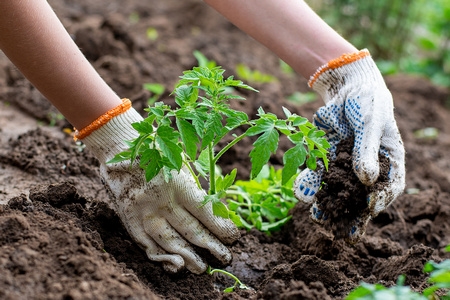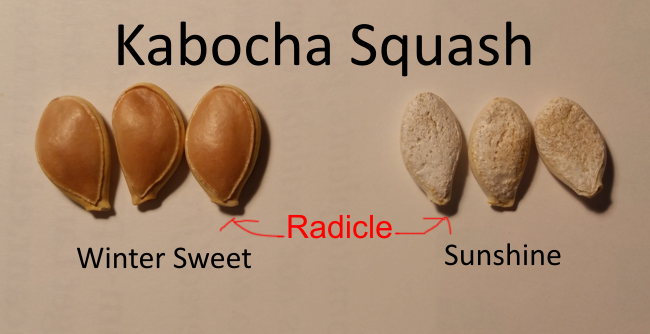- Author: Help Desk Team
We often get questions at the help desk from local gardeners who have lost many or sometimes even all their newly planted vegetable seedlings to one malady or another. Whether you have grown them from seed and tended your precious seedlings for many weeks, or have purchased them as young plants, this can be a heart-breaking occurrence. Here are seven steps you can take to give your young plants the best chance to survive and thrive.
Be patient and wait until the soil is the optimum temperature.
This applies for both purchased plants and for home-started seedlings. Your plants may have grown large enough to go into the ground, but if the outdoor temperatures are not yet at the optimal range, don't be tempted to plant them yet! When planted in soil that is too cold, many summer vegetable plants will just not grow. They are also more susceptible to being damaged or killed by fungal diseases. How does one know if the soil is the right temperature? The best way is to use a soil thermometer. A good kitchen thermometer will also work, although you may want to have one that is designated for use only in the garden. If you don't have a thermometer, watch for daytime high temperatures to remain consistently above 60 degrees and nighttime temperatures above 50 degrees. For more information on this, you may want to review our previous blog posting published on February 20th entitled: “Indoor Seed Starting."
Cool-season vegetables such as peas, cabbage, lettuce, carrots, cauliflower, broccoli, beets, and Swiss chard will do best when average temperatures range from 55 - 75ºF. Warm-season vegetables prefer temperatures that range from 65 - 95ºF. Examples of these are eggplants, tomatoes, beans, squash, melons, and peppers. Best planting times will differ for many vegetable varieties. Check seed packets or the planting guide listed below for information on the best dates for planting in your area.
CCC Vegetable Planting Guide-Interior Regions
CCC Vegetable Planting Guide-Coastal Regions
Avoid letting plants become pot bound.
Move your plants into containers that give them more room for healthy root growth. Transplanting into 4-inch, quart, and even gallon sizes is often necessary. Use a good quality soilless potting mix and avoid planting mixes and garden soil. To check if your plant needs a larger pot, gently tap the sides of the container it is in and carefully slide it out (soil, roots, and all) to look at the root growth. Transplant into larger containers before the roots begin to circle the edge of the soil, create a mat of roots at the bottom of the container, or grow out of the drain holes. Pot bound, stressed plants will often have early flower and fruit development. This can stunt their growth and impact the plant's health as well as reducing future harvests.
Harden off young plants to prepare them for their life outdoors.
Sunscald is a common problem in young plants and seedlings that have suddenly received more sunlight than they were previously accustomed to getting. Sunscald causes areas on the leaf to dry out and die, turning thin and papery and a white or light tan color. Most seedlings will bounce back from a moderate amount of sunscald damage and continue to grow new, healthy leaves. When the damage is so extensive that all or nearly all the leaf surfaces or areas of the stem are affected, the plant may not be able to survive.
To avoid this problem, plants must be hardened off. This is a process used to acclimate young plants and seedlings to the conditions outdoors. For seedlings that have been grown in a greenhouse, indoors under lights, or other protected environment, this is a crucial step. The hardening off process will take about 10 days to two weeks. Here is an excellent article from Penn State Extension with step-by-step instructions on how to harden off plants.
https://extension.psu.edu/hardening-transplants
Keep your plants safe from hungry pests- snails, slugs, earwigs, and birds.
Even the most experienced gardeners will lose some of their young vegetable plants to one or more hungry garden pests. My first suggestion is to always have a few extra plants to replace those that may get eaten. My second is if you have had problems in the past with one or more pests consuming your vegetable seedlings, start taking steps to control them before you plant. Don't wait until the damage is already done. The methods of controlling many of the pests are similar and include keeping your garden free of plant debris and favored hiding places, trapping, barriers, and baits. Baits that are safe for children, pets, and wildlife are available to the homeowner, and are very effective. Because they can take several days to take effect, it is best to use them in conjunction with the other suggested control methods. The best time to start using these control methods is several days to one week before planting.
Birds can also be a serious pest in the vegetable garden- especially early in the season as many vegetable starts are a favorite food. While there are many products advertised to scare birds away and keep them from eating your plants, bird netting is the solution that I find to be most effective. Make sure that the netting is raised above the plants to keep birds from reaching through to eat, and securely staked to the ground so that they cannot get underneath. Check your netting regularly, keep netting stretched snugly over supports, and avoid any loose ends that can trap and kill birds, lizards, and other wildlife. As plants mature, they are less attractive to the birds, and netting can often be removed. See one of our earlier blogs for more information on protecting your plants from a variety of pests: https://ucanr.edu/blogs/CCMGBlog/index.cfm?tagname=birds
Space requirements for healthy vegetable plants
Before planting it is important to consider the mature size of the plants, and the space necessary for them to grow and flourish. Vegetable plants do not do well in overcrowded situations where they need to compete for nutrients, water, and sunlight. They will tend to be stunted and much less productive than those that have plenty of room. For information on space requirements for a variety of vegetable plants, click here: https://ucanr.edu/sites/MarinMG/files/343708.pdf.
Transplanting tips, suggestions
If transplanting from flats with several plants growing in them, be sure to take up some soil with each plant as you carefully remove each one from the flat. If transplanting single plants from individual containers, try to remove them from the container with the soil as intact as possible to avoid root damage. This will be much easier to do if the plants have been watered recently and the soil in the container is well moistened. Choose a cool, cloudy day to transplant or wait until late in the day when the sun is low in the sky. Don't forget to thoroughly water your plants immediately after planting. If you have questions about the best way to handle and transplant seedlings, see this video from the Master Gardener Program of San Luis Obispo County:
https://www.youtube.com/watch?v=72dqbPZFgFY
Give your plants some shade after planting in the garden.
It is difficult to completely avoid damaging a plant's root hairs when transplanting. Root hairs are necessary to take up water and nutrients. Giving your plants some shade in the hottest part of the day for the first 5–7 days after transplanting will help keep them cooler while they regrow their root hairs. Garden shade structures do not have to be complicated and can either be purchased or made at home with items you may already have. Shade cloth, or even the plant flats used for carrying pots can be used. They are easy to set up and can be used year after year. Learn more about shading your plants in this link to a previous blog post:
https://ucanr.edu/blogs/blogcore/postdetail.cfm?postnum=55005
Be sure to look at our Master Gardener Program website to find a wide variety of useful information. Our previous blogs can also be found here: https://ccmg.ucanr.edu/
Help Desk of the UC Master Gardeners of Contra Costa County (SMH)
Advice for the Home Gardener from the Help Desk of the
UC Master Gardener Program of Contra Costa County
Client's Request: Hello, I am a Master Gardener from San Juan County in WA and have recently come to reside off Alhambra Valley Road in Martinez and would like to start planning the reestablishment of a fantastic residential garden space, both Vegetables and flowers. If you have a planting guide for this area I would like to get it via email if possible. Thank you.
UCMGCC Help Desk Response: Welcome to California. As a fellow Master Gardener, we are pleased that you thought to contact our UC Master Gardener Program Help Desk with your questions about gardening in our area. While our climate here in Contra Costa County is no doubt drier than you're used to (particularly in summer months), once you get used to it, you'll find you can raise some wonderful vegetables and flowers.
You're a bit on the late side for starting many summer veggies, but just in time to start planning a winter garden. In Central Contra Costa County where you reside, late August and early September is an ideal time to start many winter crops such as broccoli, romanesco, cauliflower and other brassicas as well as carrots, beets and other root vegetables. As you requested, I have attached a PDF copy of our vegetable planting guide for interior regions of the County. (The interior and Bayside veggie planting guides can both be found at http://ccmg.ucanr.edu/EdibleGardening/VegetablesforContraCosta/.
Unfortunately, we do not have a similar Master Gardeners planting guide for flowering plants. I can tell you, however, that particularly for low water use plants, the fall months are a good time to start new flowering plants. Typically our winter rainy starts about mid October. In "normal" rainfall years, the rains can provide the generous water amounts that even drought tolerant plants need to get established. Planting in the fall months will allow you to get started with plants that will begin to flower next spring and summer.
There are many resources that can help you select flowering plants that are suitable for growing in our climate. One that we particularly like is a plant selection tool from the UC Davis Arboretum which allows you to search their “UC Davis All-Stars”. The UC Davis All-Stars are 100 plants selected by the UC Davis horticultural staff for their toughness, reliability, ease of growth, low water requirements, and few problems with pests or diseases. The following URL allows you to search the All-Stars for plants that may be of interest to you: http://arboretum.ucdavis.edu/plant_search.aspx. You can search by plant name or plant characteristic including, at a minimum, type of plant (in your case, you would select Perennial), size (small, medium, large), exposure (full sun, part sun, shade), and whether you want California natives only. Clicking on “show/hide more criteria” allows you to narrow your search further according to water needs, flower season, flower color, and wildlife value.
If you would like to see more options, there are other websites with larger plant databases. Two such sites are: The Contra Costa Water District's: http://www.contracosta.watersavingplants.com/search.php. The Contra Costa Water District website provides access to an extensive database of native and non-native plants for their area. The link provided above allows you to go on a guided tour through the database. Like the UC Davis site, it allows you to select plants based on type (trees, perennials, annuals, ground covers, etc.) and within type by various characteristics including size, sun requirements, soil-type (sandy, loam, clay), color, blooming season. Note that you will need to check the Culture for water usage. This database includes some medium water users as well as many low and very low water users.
.
Calscape: http://calscape.cnps.org/ Calscape, which is a collaboration between the California Native Plant Society (CNPS) and the UC Berkeley Jepsom Herbarium, contains California native plants only. Calscape emphasizes the selection of natives local to your area. To begin your search, enter your location: Martinez, CA. From there you can search by plant type (tree, shrub, perennial, etc.), exposure (sun, part shade, shade), or by special category (bird and buttrfly). You can also search by plant name. Note that you need to check the water needs in the description; not all California natives for Contra Costa County are drought-tolerant.
Finally, I suggest that you consider attending our "Fall for Plants Gardening Workshop” which will be held on Sept. 8, 2018, at our Demonstration Garden in Walnut Creek. We'll be selling both winter vegetable starts and some drought tolerant plants at the event. You can watch for more information about the event on our website: http://ccmg.ucanr.edu/.
.
You are most welcome to contact us again if you have further questions.
.
Help Desk of the UC Master Gardener Program of Contra Costa County (TKL)
Note: The UC Master Gardeners Program of Contra Costa's Help Desk is available year-round to answer your gardening questions. Except for a few holidays, we're open every week, Monday through Thursday for walk-ins from 9:00 am to Noon at 75 Santa Barbara Road, 2d Floor, Pleasant Hill, CA 94523, although we will be moving late July. We will notify you when that occurs. We can also be reached via telephone: (925) 646-6586, email: ccmg@ucanr.edu, or on the web at http://ccmg.ucanr.edu/Ask_Us/ MGCC Blogs can be found at http://ccmg.ucanr.edu/HortCoCo/ You can also subscribe to the Biog (http://ucanr.edu/blogs/CCMGBlog/)
Advice from the Help Desk of the
UC Master Gardener Program of Contra Costa County
Client's Request: I need some help with pruning, grafting, and transplanting young fruit trees. I'm especially interested in growing Brown Turkey Figs.
MGCC's Help Desk Response: Thank you for contacting the UC Master Gardener Program Help desk with your questions about pruning, grafting, and transplanting young fruit trees. Some of your questions were answered on the phone and others required some “digging”.
Before pruning any fruit tree, it is important to know its bearing habits, and ultimately what shape or size you would like the tree to be when it reaches maturity. You mentioned that you would like to know how and when to prune the Brown Turkey fig that you bought and planted in a pot last year. You also mentioned that you wanted to know how and when to graft a fig branch (or scion) from your son's tree onto yours.
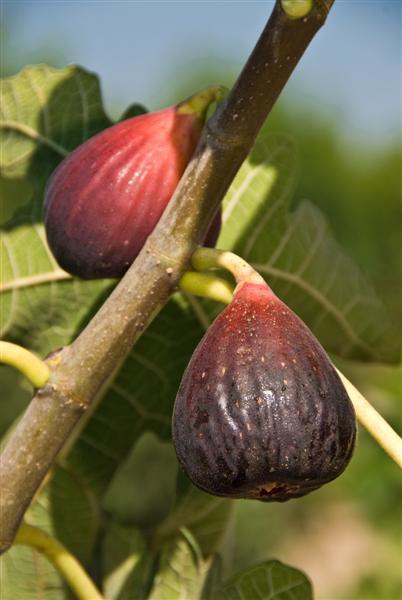
Grafting a different fig cultivar onto your tree, involves taking scion wood from a healthy tree this winter, and preserving it in a bag with moist peat moss until spring when the grating should be done. Here is a link with detailed instructions about one grafting method you might try.
https://www.gardenguides.com/125489-graft-fig-tree.html
You might also consider getting hands on experience at the Golden Gate Chapter of the California Rare Fruit Growers Scion exchange on January 20th in Berkeley. Here you may take a grafting workshop, as well as finding hundreds of varieties of budwood for grafting and cuttings to root. Please see the following website for more information about the event, as well as its location. http://www.crfg.org/chapters/golden_gate/scionex.htm. (Editor's note: Many years ago, I attended the CRFG's Scion Exchange and brought home scions of 22 different types of figs. I planted them all directly 1 each in gallon containers. They all survived, much to my surprise, since I'm not fond of figs. Fig Newton cookies yes. They eventually all were donated to dia to a much better fate than my garden.)
You also mentioned that you have a two-foot-tall volunteer fig tree in your yard that you'd like to transplant. The best time to dig up and transplant a fig is now during its winter dormancy period. You will need to measure the trunk and calculate that for every inch of trunk diameter, you will need to allow for ten inches of root ball diameter when digging. So, if your tree is 1 inch in diameter you'll have to allow for an almost 1 foot diameter of root ball. You should also dig the root ball at least 1” beyond the canopy of the tree to minimize damage of any lateral roots.
Other important facts when transplanting your fig tree include: planting it in full sun, digging the new hole no deeper than the root ball, using existing soil when back filling the hole, and avoiding planting in areas that collect water, in order to mitigate the possibility of “wet feet”, which might make the tree more susceptible to root rot. Use the following link for a comprehensive guide to fruit tree planting and care. http://homeorchard.ucdavis.edu/8048.pdf
For more all-inclusive information on how to prune, including shaping, types of pruning cuts, and much more, see the following link. http://homeorchard.ucdavis.edu/8057.pdf
This is a lot of information to take in, but I hope that you are successful in your home gardening pursuits, especially for your fig trees.
Help Desk of the UC Master Gardener Program of Contra Costa County (JJM)
Note: The UC Master Gardeners Program of Contra Costa's Help Desk is available year-round to answer your gardening questions. Except for a few holidays, we're open every week, Monday through Thursday for walk-ins from 9:00 am to Noon at 75 Santa Barbara Road, 2d Floor, Pleasant Hill, CA 94523, although we will be moving sometime soon. We will notify you if/when that occurs. We can also be reached via telephone: (925)646-6586, email: ccmg@ucanr.edu, or on the web at http://ccmg.ucanr.edu/Ask_Us/ MGCC Blogs can be found at http://ccmg.ucanr.edu/HortCoCo/ You can also subscribe to the Blog (http://ucanr.edu/blogs/CCMGBlog/)
Advice for the Home Gardener from the Help Desk of the
UC Master Gardener Program of Contra Costa County
Client's Request: I went on Tuesday evening to a very good presentation at the Lafayette Library by Master Gardeners. I had a question that the presenters could not answer and their advice was to ask it directly to the Help Desk -- so, here it is....
I have planted a new garden with native plants and have not added any amendment to support the plants' growth. I read online that mycorrhizal fungi can be added after the plant has been set in the ground and it will enable healthier root and plan growth. Is that correct?
Help Desk Response: Thank you for contacting the UC Master Gardener program regarding mycorrhizal fungi and your native garden. We know that plants and mycorrhizal fungi live in a symbiotic relationship, very beneficial to both species. The fungi colonize the plant roots, helping with uptake of water and minerals. It is well known that plants in healthy soils with good mycorrhizal colonization are much healthier. You can promote this by appropriate irrigation, minimizing soil disturbance by not tilling, and limiting fertilizer, especially phosphorus. Also, using a surface mulch will help.
There have been many studies on the effects of mycorrhizae on growing plants, which show definite benefits, but it is not clear that adding them to an existing landscape is helpful. There are many different species of mycorrhizae, and it seems that they need to be adapted to the particular environment or plant species, and if you add 'foreign' ones, those native fungi already present may defend their territory and your garden will receive little or no benefit. Also, one study that I know of looked at viability of commercially available mycorrhizae inoculants and found that some did not have any live ones! That being said, if you still want to try this, a reputable and appropriate source should be used.
If your garden was prepared appropriately, and the plants are healthy and thriving, and you are using mulch, it should be fine without adding the mycorrhizae. In addition, I could not find any recommendation to add mycorrhizae for this situation on the California Native Plant Society website: http://www.cnps.org/cnps/grownative/getstarted/starting_a_garden.php
I hope this has been helpful and that your garden will thrive. If you have further questions, please feel free to contact us again.
Help Desk of the UC Master Gardener Program of Contra Costa County (SMW)
Note: The UC Master Gardeners Program of Contra Costa's Help Desk is available year-round to answer your gardening questions. Except for a few holidays, we're open every week, Monday through Thursday for walk-ins from 9:00 am to Noon at 75 Santa Barbara Road, 2d Floor, Pleasant Hill, CA 94523. We can also be reached via telephone: (925)646-6586, email: ccmg@ucanr.edu, or on the web at http://ccmg.ucanr.edu/Ask_Us/ MGCC Blogs can be found at http://ccmg.ucanr.edu/HortCoCo/ You can also subscribe to the Blog (http://ucanr.edu/blogs/CCMGBlog/)
- Author: Richard Hornberger
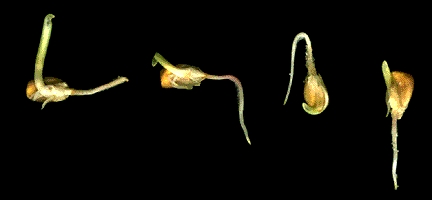
For many years, I have been sowing seeds in the ground, but in the last four years, I have been moving to indoor propagation of vegetables and flowers under controlled heat and lighting conditions. Typically, I sow seeds in an open or multi-cell planting tray using a soil mix of compost, peat moss, perlite, and vermiculite. I have also used Rockwool cubes with success, but I prefer a light soil mix.
I am always looking for new information that will help improve my propagating techniques. A few months ago, while googling seed propagation, I came across an article by Stephen Scott of Terroir Seeds, about seed orientation. Scott believes that pointing the seed in the right direction (meaning with the root in the down direction) when planting will improve germination rates and vigor of the plant.
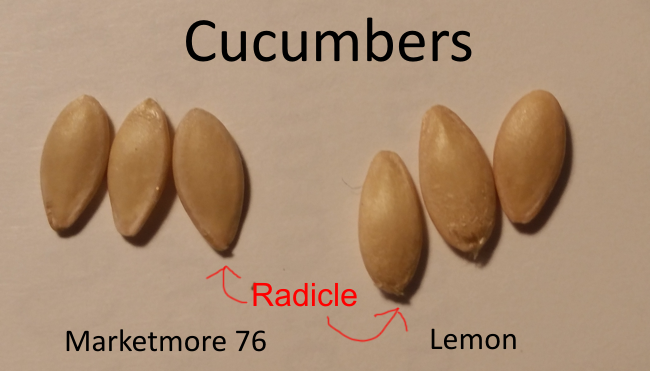
Before painstakingly planting my seeds with the radicle pointing down, I decided to research this theory a little more. One of the first web “hits” to come up was a repeat of the same article posted on the Monterey Bay Master Gardener Blog. I also found a similar article written by Master Gardener and Environmental Scientist, Diana K. Williams at SFGate. However, I wasn't able to find any UC Davis studies on the subject. Interestingly enough, the few university-based studies I did locate either did not support this idea, or directly contradicted it, such as studies with cucurbits (squash, pumpkins, watermelons, and cucumbers) that showed higher germination and vigor rates when the radicle is planted in the upward direction. While this is not a widely studied subject, most folks who have studied the subject make it clear seed orientation does not affect germination or vigor.
Although a little let down that the seed orientation theory came to naught, I nonetheless enjoyed my on-line sleuthing, and for now at least, I'll continue to plant my seeds without worrying about orientation.


